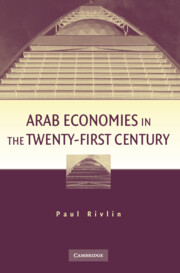5 - Egypt
The Submerged Giant?
Published online by Cambridge University Press: 05 June 2012
Summary
Egypt is the largest Arab country in demographic terms and has one of the largest economies in the region. Economic conditions in Egypt are harsh, with 2006 gross domestic product (GDP) per capita of US$1,350. Egypt's political influence within the Arab world and in the Middle East as a whole is considerable. As a result, the economic policies that it follows are something of a weathervane for Arab countries.
Decision making has been gradual, with a move away from socialism dating back to the 1970s. Despite this, the economy remains centrally run; the public sector is large and the private sector is reliant on the state. Behind all economic decisions there is the need to take into account annual population growth of more than one million. As a result, Egypt has failed to overcome many of the socioeconomic problems that it faced at the time of the 1952 revolution.
Demographic Trends
In 2005, Egypt's population was estimated at 74 million, some 24 percent of the Arab world's population. In demographic terms, it was the third largest country in the Middle East after Turkey and Iran. The rate of population growth in Egypt has fallen as it experienced demographic transition. Despite this, the absolute annual increase in the population currently exceeds one million and the number of people reaching working age and entering the labor market each year may be as high as 900,000.
- Type
- Chapter
- Information
- Arab Economies in the Twenty-First Century , pp. 95 - 131Publisher: Cambridge University PressPrint publication year: 2009



